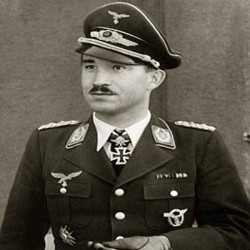
Adolf Galland
| Date of Birth | : | 19 Mar, 1912 |
| Date of Death | : | 09 Feb, 1996 |
| Place of Birth | : | Herten, Germany |
| Profession | : | Fighter Pilot, Aviator |
| Nationality | : | German |
Adolf Galland German fighter ace and officer who commanded the fighter forces of the Luftwaffe (German air force) during World War II.
Early life
Galland was born in Westerholt (now Herten), Westphalia on 19 March 1912 to a family with French Huguenot ancestry. The first Galland in Westerholt was a refugee from France in 1792 from Veynes. He became a bailiff to the count von Westerholt, beginning a tradition that was handed down from father to son. Adolf Galland (junior) was the second of four sons of Adolf Galland (senior) and his French wife Anna, née Schipper. Upholding the family tradition, Galland (senior) worked as the land manager or bailiff to the Count von Westerholt. Galland's older brother was Fritz and his two younger brothers were Wilhelm-Ferdinand and Paul. Their father had pet names for all his family members. His wife Anna was called "Anita". Fritz, his older brother, was called "Toby", Adolf was "Keffer", Wilhelm-Ferdinand was nicknamed "Wutz" and Paul was called "Paulinchen" or since they were expecting a girl, occasionally "Paula".
His two younger brothers also became fighter pilots and aces. Paul claimed 17 victories, before being shot down and killed on 31 October 1942. Wilhelm-Ferdinand, credited with 55 victories, was shot down and killed on 17 August 1943.
In 1927, Galland's lifelong interest in flying started when a group of aviation enthusiasts brought a glider club to Borkenberge, a heath east of the Haltern-Münster railway and part of the Westerholt estate. It was here that the Gelsenkirchen Luftsportverein (Air Sports Club of Gelsenkirchen) created an interest in flying among young Germans. Galland travelled by foot or horse-drawn wagon 30 kilometres (19 mi) until his father bought him a motorcycle to help prepare the gliders for flight. By 19 Galland was a glider pilot. In 1932 he completed pilot training at the Gelsenkirchen Luftsportverein.
Under the Treaty of Versailles, Germany was denied an air force. They were however allowed gliders and it became the way for fledgling pilots to begin their flying career. The sport became so popular that the Reichswehr set up ten schools, at least one in each of the seven military districts of Germany. The military also published a magazine, Flugsport (Flight Sport), to encourage an interest in aviation and began a series of glider competitions around the country. Galland had learned the basic laws of flight and how everything worked on paper, but he found they did not always work in reality and his inexperience caused a few accidents. One of his tutors, Georg Ismer, taught him various techniques and in 1929 the 17-year-old Galland passed his A certificate. This was one of three certificates he needed for his professional license. When he eventually attained his B and C certificates, his father promised to buy him his own glider if he also passed his matriculations examinations, which he succeeded in doing. Galland became an outstanding glider pilot; he became an instructor before he had passed his Abitur.
Biography
The son of an estate bailiff of French descent, Galland became a skillful glider pilot before age 20 and joined the civilian airline Lufthansa in 1932. He served with Germany’s Condor Legion in the Spanish Civil War in 1937–38, flying several hundred missions. Galland held a staff post when Germany invaded Poland in 1939, but he went on to serve in a fighter group during the campaign against France in 1940 and led a fighter squadron during the Battle of Britain, by the end of which he had destroyed about 100 enemy planes. In November 1941 he was promoted to the post of commander of the Luftwaffe’s Fighter Arm, and a year later he was promoted to major general, becoming at age 30 the youngest general in the German armed forces.
In 1943–44 Galland commanded Germany’s fighter squadrons in their unavailing defense against Anglo-American bombing raids. Despite his able and resourceful leadership, he was blamed by Adolf Hitler and Hermann Göring for the gradual collapse of the German air defenses in 1944, and he was relieved of his command in January 1945. He was soon returned to active duty as the commander of an elite squadron of jet fighters. At the war’s end he was captured and imprisoned for a time. He later served as a technical adviser to the Argentine air force for six years, after which he returned to West Germany and worked as an aviation consultant in Düsseldorf.
Aerial victory claims
According to US historian David T. Zabecki, Galland was credited with 104 aerial victories. Mathews and Foreman, authors of Luftwaffe Aces – Biographies and Victory Claims, researched the German Federal Archives and found records for 100 aerial victory claims, plus nine further unconfirmed claims, all of which claimed on the Western Front. This figure of confirmed claims includes two four-engined bombers and six victories with the Me 262 jet fighter.
